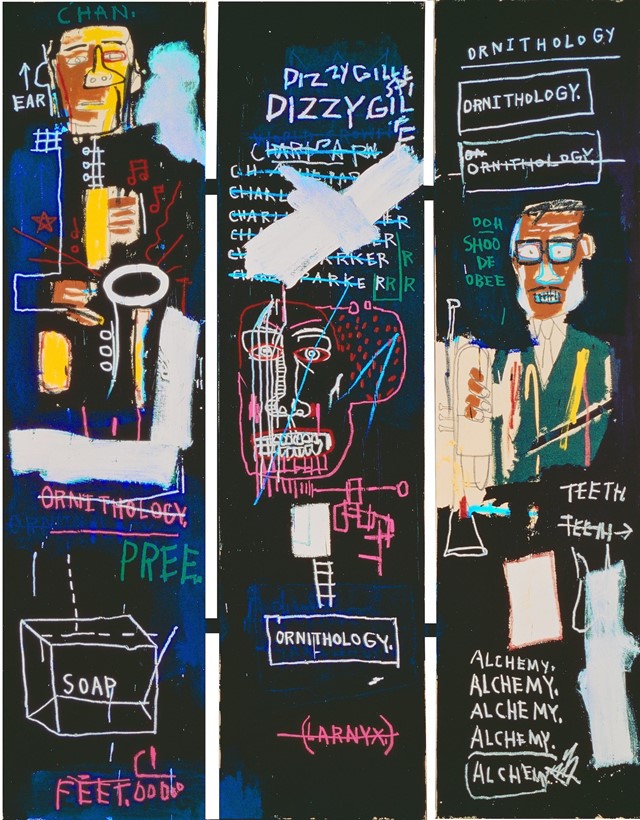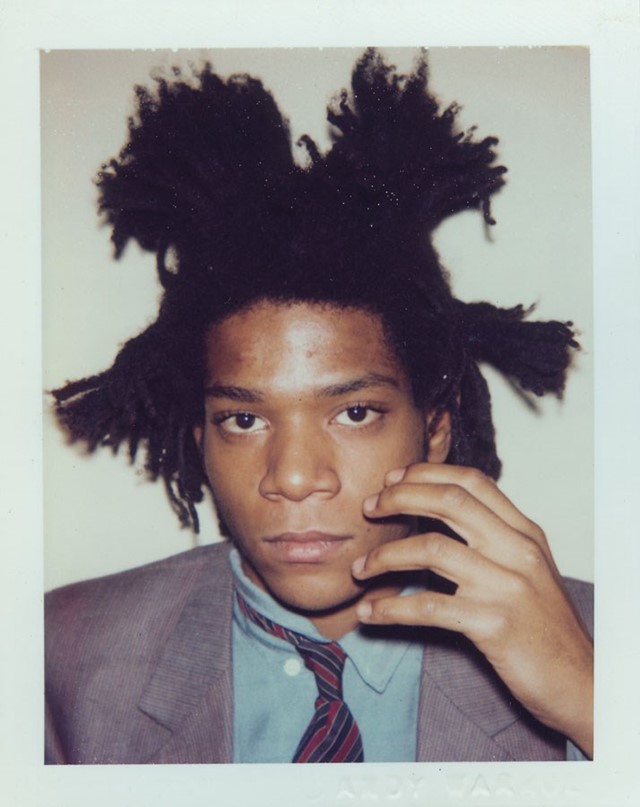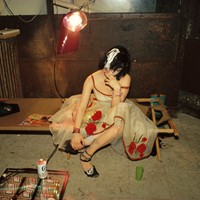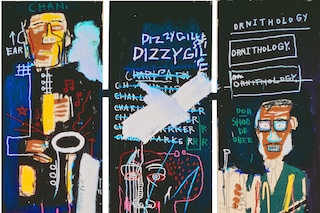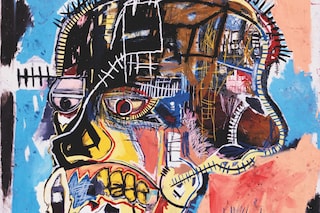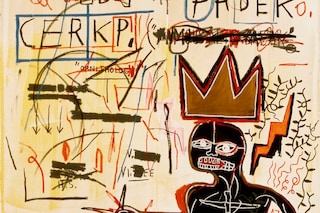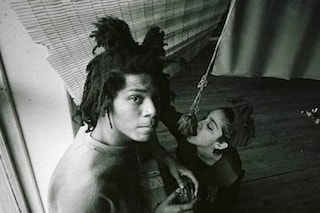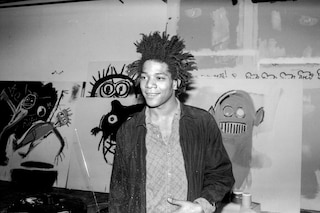Our obsession with the artist is undeniable, but the endless film adaptations, TV shows, and sneaker collabs gloss over vital elements of his art
Even before his death at 27, Jean-Michel Basquiat occupied a near-mythical space in the art world of 80s New York. Famously painting his politically-charged canvases in bare feet and an Armani suit, he walked a tightrope between personas: the rebellious graffiti artist who slept on the street and started out tagging SoHo galleries as one half of SAMO©, and the glamorous, groundbreaking painter who charmed the art establishment in the final years of his career.
Maybe it was Basquiat’s complex mythology that allowed him to become the “most famous of only a small number of young black artists who [had] achieved national recognition” at the time of his death, as described in a 1988 New York Times obituary. However, this obituary also illustrates how Basquiat’s fame continued to grow in the decades that followed. The prices it cites for contemporary Basquiat auctions – up to $99,000, or about $235,000 adjusted for inflation – pale in comparison to the record-breaking sale of “Untitled” (1982) for $110.5 million in 2017.
With the remarkable economic appreciation of Basquiat’s work, of course, comes another variety of appreciation: the kind of cultural admiration, bordering on obsession, that leads people to get the artist’s “Pez Dispenser” dinosaur tattooed on their calf, or Urban Decay to slap his ubiquitous crown motif on its eyeshadow palettes, or Urban Outfitters to reduce his masterful “Horn Players” triptych to a trendy t-shirt decal.
Yes, Basquiat’s artwork has strayed far from its underground roots — and maybe that’s old news by now, but the real reworking of the artist’s legacy is just getting started. In January this year, filmmaker Julius Onah announced a major new biopic, starring Dazed 100 alum Kelvin Harris Jr (Onah will be the first Black filmmaker to helm a retelling of Basquiat’s life). Then there’s Kwame Kwei-Armah’s Young Vic play, The Collaboration, a dramatisation of Basquiat’s unique relationship with Andy Warhol. But that’s not all. Last week (February 24), Variety also shared news of a new limited series that revolves around “the rise of Basquiat, from an obscure graffiti artist to a Neo-expressionist painter of rockstar status”. If Beale Street Could Talk’s Stephan James is already attached to star in the as-yet-untitled project.
All this interest might be seen as a sign of Basquiat’s enduring success. 40 years on, it suggests, he still connects with people enough that they’re willing to shell out more than a full day’s wage on a pair of Dr. Martens wrapped in his artwork, or sink hours of their time into a dramatisation of his life and career. Maybe this is just how we measure an artist’s impact in our little late-capitalist hellscape, in terms of what we can buy to show our allegiance. How many posthumous sneaker collabs do they have? What’s the weirdest merch crossover with their name attached? Who’s going to play them in Ryan Murphy’s next Netflix melodrama?
For fans of Frida Kahlo or Keith Haring, this phenomenon is all too familiar. Kahlo’s image, in particular, has been ungraciously unpicked over the last decade, and spun into vaguely racist Snapchat filters, blatantly inaccurate Barbie dolls, and – surely worst of all – that bracelet worn by Theresa May at the Conservative party conference in 2017. As pointed out in the past, though, this kind of reverence is mostly surface-level, glossing over the actual message of the art, or cherry-picking its more convenient elements (see: a Tory politician celebrating the “girl power” of a staunch communist who stood for pretty much everything she’s against).
This has some pretty clear parallels with the surge in Basquiat’s public appeal. As Black Lives Matter protests gripped the world in 2020, following the murder of George Floyd, Breonna Taylor, and Ahmaud Arbery, supporters looked to his art for inspiration – Basquiat himself confronted the 1983 death of a 25-year-old graffiti artist, after a beating by New York City police officers, in “Defacement (The Death of Michael Stewart)” – while imagery from his oeuvre appeared in commemorative murals. From a more cynical perspective, though, the products that appropriate his work (albeit with the go-ahead from the Estate of Jean-Michel Basquiat) offer a way for people to perform allyship without actually having to take meaningful action. Updated takes on his art are a way to show support without compromising the aesthetics of your Instagram grid.
At this point, it’s probably worth stopping to consider: what would Basquiat have wanted? Just like Kahlo and Haring – or Van Gogh, Matisse, and countless other artists – Basquiat had virtually no control over where, or how, his image would travel after his death. More than many other artists, however, Basquiat’s attitude toward his own posterity is difficult to pin down, coloured by disillusionment on the one hand, and on the other, a Warholian obsession with the trappings of fame.
Olivia Laing notes this complexity in a 2017 essay on Basquiat, included in her career-spanning collection Funny Weather: Art in an Emergency. “These days Basquiat is among the most expensive artists in the world,” the author writes, “his image franchised and replicated everywhere from Urban Decay blusher pots to Reebok trainers. You could scorn the commercialisation, but isn’t it what he wanted, to colour every surface with his runes?”
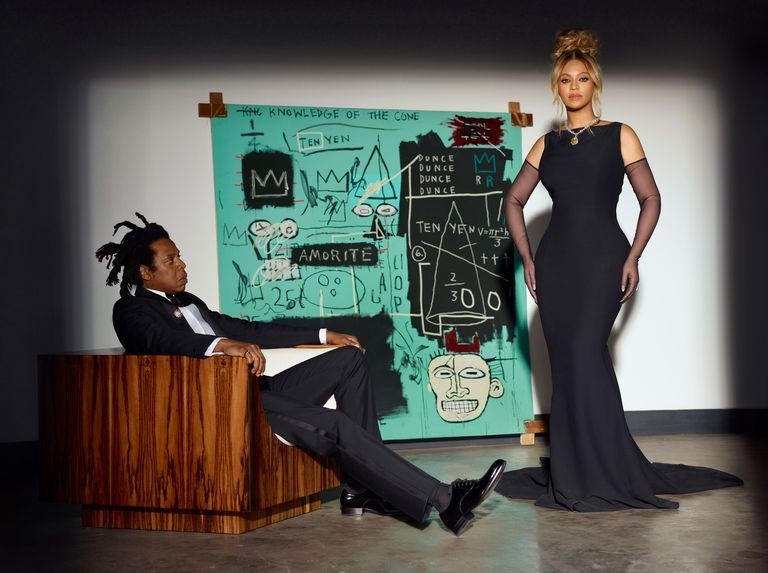
This question also divided Basquiat’s friends and fans prior to the recent goldrush to turn Basquiat’s complex life into digestible content, sparked by the 2021 Tiffany’s ad that saw Jay-Z and Beyoncé pose in front of the Tiffany-blue Basquiat painting Equals Pi. “I was horrified,” Alexis Adler, the artist’s former flatmate, told the Daily Beast in response to the ad. “The commercialisation and commodification of Jean and his art at this point – it’s really not what Jean was about.”
Basquiat’s studio assistant Stephen Torton also pointed out the irony of the “exploitation”, saying that Basquiat wouldn’t have been allowed into a Tiffany’s store “if he wanted to use the bathroom or if he went to buy an engagement ring and pulled a wad of cash out of his pocket”. Artist, actor, and #1 muse Julia Fox, however, weighed in on the other side of the debate, sharing her opinion via Diet Prada’s Instagram comments: “Basquiat was obsessed w being famous. He would love that THE QUEEN Beyoncé and her husband posed in front of his art!!!”
Barring a clairvoyant revelation, of course, we’ll never know how Basquiat would feel seeing his paintings scaled down on a pair of Converse, or moments of his life fictionalised for our viewing pleasure. On the plus side, maybe the endless parade of products and shows will bring his art to a wider demographic and encourage them to dig deeper into his artistic intent. Maybe their producers aren’t just cashing in on an artist at the height of his art market appeal, edging us ever closer to a point of cultural saturation, where Basquiat becomes synonymous with the kitschy gifts you receive off well-meaning grandparents on your birthday. Maybe they really intend to spread the radical messages encoded in his “runes” and advance his political agenda, on top of their own profits. That seems unlikely, though, doesn’t it? The kind of difficult conversations that Basquiat provoked with his art are not, generally speaking, what sells.
